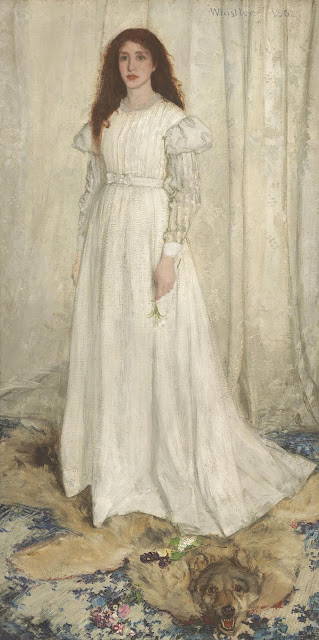Whistler's Woman in White
Who knew that there were two Whistlers who liked to paint? Until a few weeks ago, not me. Conflating Rex Whistler and his racist mural at Tate Britain with James Abbot McNeil Whistler is probably an easy mistake to make, and at least it was one that I realised before taking in Whistler’s Woman in White at the Royal Academy earlier in the month.
Who was the 'woman in white' then? Joanna Hiffernan, an Irish model and muse is the figure that we find staring blankly out at us from Symphony in White, No. 1: The White Girl. When first exhibited, the painting titillated, thrilled and caused a minor sensation. The French novelist Émile Zola even found a place for it in L'Œuvre, a novel detailing the struggles of an artist and his quest to paint a revolutionary masterpiece and his subsequent battles with the critics and the wider public. In a kind of fictional Salon des Refusés, alongside Édouard Manet's Le Déjeuner sur l'herbe, we find our Whistler.
 |
| Symphony in White, No. 1: The White Girl |
Whistler and his lover and muse might be the gravity that grounds the exhibition, but it is the other artists – sometimes unexpected – that lift us into the air. Gustav Klimt's gorgeous and dramatic Portrait of Hermine Gallia (1903) is encountered immediately on entering.
 |
| Gustav Klimt, Portrait of Hermine Gallia (1903) |
And then there are the Courbets. A selection of Normandy seascapes are interesting - they almost seem at odds with the rest of the exhibition - and so, instead, you turn to an adjacent wall where there are three near-identical paintings of Hiffernan that take your eyes from left to right, and then back to the left . Jo, the Beautiful Irishwoman has Hiffernan brushing gazing into a hand-mirror and toying with her locks. Unlike with Whistler's White Girl, there's character in this face - or rather all three faces - and emotion isn't drained in the service of finding some strange ideal of purity. It is a quiet privilege to compare the three paintings and decide which is your favourite and which one is reputed to be the finished article. I think I'd go for the one that belongs to the New York Metropolitan Museum of Art (pictured below):
.jpg) |
| Gustave Courbet, Jo, the Beautiful Irishwoman (1860) |
Those curly-tresses stay with you. Later, I was intrigued to learn that Hiffernan was rumoured to be the model for his infamous L'Origine du monde (1866). That has since been debunked. What took them so long? A simple up and down appraisal of the flame-haired red-head would have solved that one.
Lingering in my mind the longest, though, was Whistler's The Artist in His Studio. The artist, palette and paintbrushes in hand, catches us looking, whilst two women, one standing and gazing into a mirror, the other reclined on a chaise lounge, seem to suggest that this isn't really a studio. What draws you in are the muted colours of the women's dresses. Both of these garments, particularly the one worn by the standing woman, have an exquisite diaphanous quality. A hint of a darker undergarment provokes you to come closer, and the partial solidity of all three figures vanish like phantoms and you are left smiling at a handful of seemingly haphazard squiggles that bear no relation to the whole. Whistler himself, seems to be evaporating from the waist down. This all brings a wonderful melancholy to the painting.
 |
| The Artist in his Studio, 1865 and 1895 |
It seems unfinished. Indeed, the painting was started in the 1860s, and then 'touched up' - I love that phrase in relation to this work - some thirty years later. But I was also left puzzled. The label next to the painting suggests that Whistler was trying to re-create a version of Velazquez's Las Meninas. Yet apart from the mirror I struggled to join the dots here. Indeed, mirrors reflecting the artist back at us aren't unique to Velazquez's most famous work: Jan van Eyck's Arnolfini Portrait, which seems to have more in common with this particular Whistler springs immediately to mind. It all seemed rather tenuous, but then reading up on the Velazquez and honing in on the English translation of his painting - 'Ladies in Waiting' - it all seemed to click. The Spanish artist's ladies are attached to the Court; Whistler's ladies are attached to him. Possessive and subjugating, or playful and erotic? Either way, the uncertainty and illusions inherent in the Velazquez are seized upon by Whistler and funneled into this exquisite work.
Unfairly, this exhibition has had some poor reviews. 'A mess' was the verdict of the Evening Standard's critic, who went on to suggest that whilst the main portrait was a 'fine one', it wasn't enough to hold the whole together. I disagree. I think the main portrait almost seems to fade into the background, whilst the satellite works come to the fore. Perhaps therein is the key to Hiffernan's blank look - a bewilderment as to what it was that caused all of the fuss in the first place. I return to Zola's sentences and read them again and try to imagine the reaction that this painting caused. My look - if I was to catch it in the mirror - might just be the same as Hiffernan's.


Comments
Post a Comment